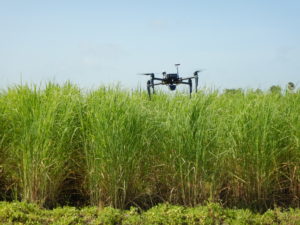
Energy cane imagery collection using DJI Matrice 100 platform with SlantRange 3p sensor
Sensors are used to collect data on crop plants that can be used in farm management and genotype selections in breeding operations. Proximal sensing involves the use of sensors in close proximity to the plants, such as on a tractor or harvester or ground-based robot. Remote sensing involves the use of sensors at a distance from the plants, such as on a satellite, a manned aircraft, or an unmanned aerial vehicle (UAVs) or drone. Many of these sensors are imaging sensors, so much of the research involves analyzing images to extract important data about crop responses to various environmental conditions. The Cotton Engineering program has been conducting research in both proximal and remote sensing for cotton-specific applications.
Projects:
-
Field-based Detection and Removal of Plastic Contamination of Cotton
Any non-cotton material in a bale of cotton fiber is undesirable, and some contaminants like plastics can cause major problems when spun into yarn along with cotton fiber. One point at which plastic contaminants can enter cotton is during harvest, when various types of plastic like shopping bags may be present in a farm field, and pieces are inadvertently ingested into the harvester along with the seed cotton. Therefore, the Cotton Engineering program has been conducting research to determine whether plastic shopping bags that may blow into a cotton field can be detected and potentially removed by a UAV flying over the field with a camera.
-
Enhancing Accuracy and Reliability of Image Data from UAV Remote Sensing
Images that are captured with UAVs can potentially be used to make decisions about when and where to apply irrigation water, defoliant, pesticide, etc. It is critical that these images contain information that is consistently accurate and trustworthy. The Cotton Engineering program has been conducting research on methods to calibrate UAV image data, and the accuracy of the data has been vastly improved with the methods developed in this project. The methods involve not only UAVs but also ground-based robots that position themselves under the UAV during image collection serve as references for calibrating the data.
-
Detection, Identification, and Mitigation of Volunteer Cotton Plants
Volunteer or “feral” cotton plants are those that were not planted as part of a crop in normal farm operations. These plants can result from seeds left (1) in the field from a prior growing season, in which case cotton plants may grow up in a corn field, for example; (2) in areas where seed cotton modules were stored; and (3) along roadsides where modules are transported from the field to the gin and seed cotton blows off the truck. These plants can present a growth habitat for destructive insects like the cotton boll weevil, so it is important to either destroy them or treat them. The Cotton Engineering program has been conducting research to determine whether feral cotton plants can be detected by a UAV flying over the field or roadside with a camera.
-
Robotics and Biophotonics Enabled Plant Phenotyping
Plant breeders conduct research to find crop plants that have higher yield, are resistant to pests, are drought-resistant, or have other desirable characteristics. They grow numerous plots of various genetic varieties of and record data on important parameters of the plants so they can make decisions about which genotypes to select for future study and development. Collecting data on these parameters is called phenotyping, and modern methods of “high-throughput phenotyping” (HTP) incorporate robotic platforms that carry sensors to collect the data. The Cotton Engineering program is conducting research on combinations of sensors and robotic platforms for HTP in order to provide cotton breeders new tools for crop improvement.
-
Detection and Removal of Plastic Contamination of Cotton
The Cotton Engineering program has been seeking to develop methods to detect and potentially remove pieces of plastic in the seed cotton at one or more process locations in the cotton gin.